Sheffield’s Street Tree Strategy - why is it important?

The final strategy for the future of Sheffield’s street trees will be released on Monday, following almost two and a half years of partnership between Sheffield City Council, street tree campaigners, and private contractor Amey.
The strategy comes after years of protests, arrests, and controversy around Sheffield’s street trees, and will commit to the planting of more trees, as well as more transparency in the council's actions around them. But why is the strategy so important, not only to those involved in the street tree controversy in Sheffield, but to the entire country? To answer that question, you need to go back to how this started, and how things have gotten to where they are now.
Photo: Thomas Parker
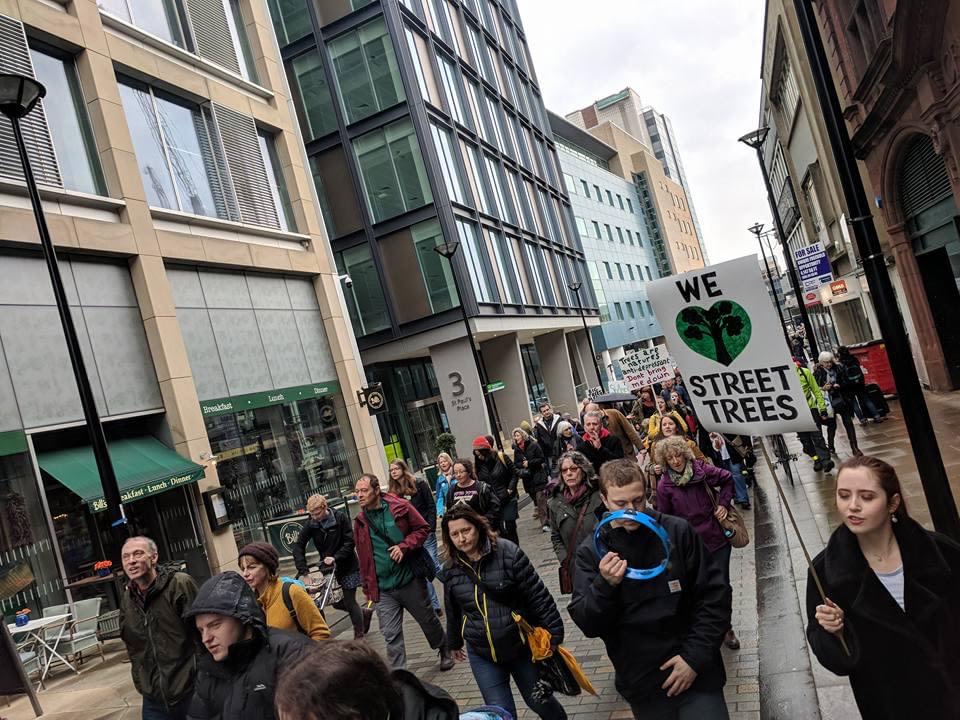
Rumblings of discontent
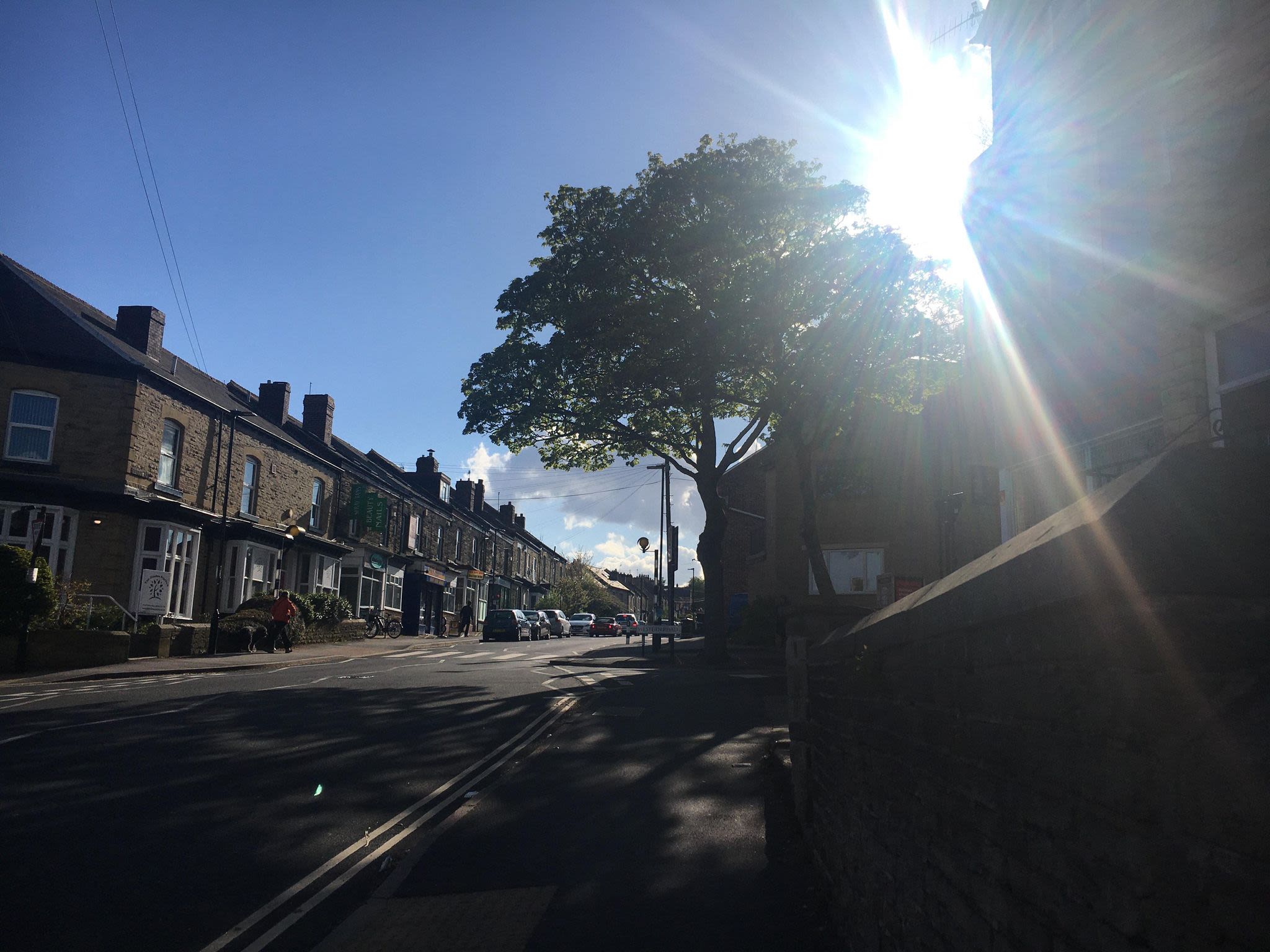
November 2nd, 2016. There had been countless protests before, but this one was different. There weren’t just Amey contractors who had turned up on Marden Road to fell trees, this time they were backed up by South Yorkshire Police. They’d tried to fell trees on this street before, but protesters had gotten in the way. This time, they weren’t taking no for an answer. Protesters were told that if they interfered this time around, they would be arrested. More specifically, they would be arrested using trade union legislation, which is primarily used for breaking up picket lines during strikes.
Two people were arrested that day, and 12 more were arrested over the next four months. It was a staggering raising of stakes.
Calvin Payne was one of the people arrested on Marden Road. He said: “When I got arrested I knew what I was doing. We wanted to be in court for the media publicity.
“Since 2015 we had been winning the argument, we had been going to council meetings, we had been signing petitions, but the council didn’t care.
"Trees were being cut down in their thousands by then. If we’d carried on like that we would have won the argument, but all the trees would have been chopped down.”
To outsiders the arrests that day may have seemed shocking and sudden, but to those protesting the fellings, and to those in the council, they came as no surprise. It was the natural next step in a bitter battle which saw both sides do nothing but double down on their convictions for six years straight.
What happened on that day in November 2016 had been bubbling to the surface ever since 2012, when a contract was signed binding Sheffield City Council to the felling of trees for the next 25 years to come.
Contract controversy
When the details of the Private Finance Initiative (PFI) contract were announced between Sheffield City Council and highways maintenance contractor Amey, it looked extremely positive: £2.2 billion is being spent on the 25-year “Streets Ahead” scheme to replace and maintain the city's roads, pavements, lights, and street trees. It should have been a huge step forward in the development of Sheffield as a cutting edge, modern city. Instead, within just two years, things started to unravel.
Much of what was proposed in the Streets Ahead scheme was regarded as positive, but nobody at the time could have anticipated the backlash and controversy that would surround the street trees. Amey had agreed to remove and replace trees in the city if they came under one of six Ds:
Dangerous
Dead
Diseased
Dying
Damaging
or Discriminatory.
Trees that came under the first four of these were universally regarded as needing to be removed. However, the last two formed the basis for protests - 'damaging' trees were seen to be damaging pavements or kerbs, and 'discriminatory' trees were seen to be preventing access for certain people - for example, if they restricted wheelchair access on a pavement.
On paper, neither of these sound controversial either, but in practice they meant the removal of thousands upon thousands of Sheffield’s street trees. Protesters argued that as they were healthy, there were ways to save them without cutting them down.
It wasn’t until some years later that Sheffield City Council revealed that in the contract with Amey, they had directed for 17,500 trees to be cut down and replaced - half of Sheffield’s street trees.
In 2015, three years after the fellings had begun, protests started in earnest. Local protest groups cropped up all around Sheffield, created by residents who were angered by trees being felled on their roads. These protest groups came together to form STAG, or Sheffield Tree Action Groups.
Even by then, with groups formed and action being taken, things were still quite calm.
Calvin explained: “There was a very slow build up with occasional little battles.
“The council kept the big fights back, they didn’t try to fight the places where they knew there was opposition, they picked off places where they knew there wasn’t.
“It wasn’t until Rustlings Road in 2016 that things really ramped up.”

Calvin Payne (left) and Simon Crump were the first protesters to be arrested. Photo: Graham Turnbull
Calvin Payne (left) and Simon Crump were the first protesters to be arrested. Photo: Graham Turnbull

Photo: Paul Selby
Photo: Paul Selby

The Streets Ahead contract has caused serious controversy
The Streets Ahead contract has caused serious controversy

STAG frequently held demonstrations in Sheffield city centre. Photo: Rebecca Hammond
STAG frequently held demonstrations in Sheffield city centre. Photo: Rebecca Hammond
Rustlings Road

By the end of 2016, over 4,000 trees had been felled. STAG had been growing gradually, but they simply didn’t have the numbers to prevent most of the fellings. The events had received national attention by this point, with Nick Clegg, previously Deputy Prime Minister and Sheffield MP, branding the controversy a “national scandal”. This sentiment was shared across the political spectrum. When he was Environment Secretary, Michael Gove visited Sheffield and labelled the fellings as “bonkers”.
Despite the national spotlight, and the steady uptick in support for STAG, things were getting worse. Arrests had just begun, trees were still being cut down at a breakneck pace, and the council showed no sign of letting up.
Rustlings Road changed everything.
In the middle of the night residents on the road awoke to a hammering at their doors, and opened them to reveal police officers. The only explanation for a knock at that time of night, some of them thought, was the news that a family member had died.
Thankfully the news wasn’t as devastating as that, but it would come to define the street tree campaign. Residents were ordered to move their cars - it was 5 o’clock in the morning, and Amey were there to fell the trees on the road.
Calvin said: “I got the call out at 5am, I rushed over there and I was in a state of shock.
“I got there and didn’t really do anything, and neither did anyone else, we all just stood there.
“Two people held a brief protest and were promptly arrested, but my main memory from that night is that we didn’t do anything, it was totally different to any other street I’ve taken part in.”
The decision to fell trees in the middle of the night in order to avoid protesters crossed a line for many people, and not just tree campaigners.
Calvin said: “Rustlings Road was the biggest recruiter for our campaign.
"People were outraged by what happened, which meant they got involved.
“Almost everybody that became key to the Sheffield tree campaign got involved because of what happened on that day."
The numbers speak for themselves - within five days of the Rustlings Road fellings, STAG membership had more than doubled, from 4,000 to over 8,000.
Suddenly, with a ballooning number of people supporting the campaign, STAG were able to prevent scores of trees from being chopped down which had previously seemed destined to felling. It meant a lot more protests, a much bigger police presence in response, and a spike in arrests.
The next major controversy came just three months later. Protests were in full swing up and down Sheffield, and Chippinghouse Road was the next target.

"Axe PFIs, Not Trees". Photo: Alan Story
"Axe PFIs, Not Trees". Photo: Alan Story

Photo: Ian Challis
Photo: Ian Challis
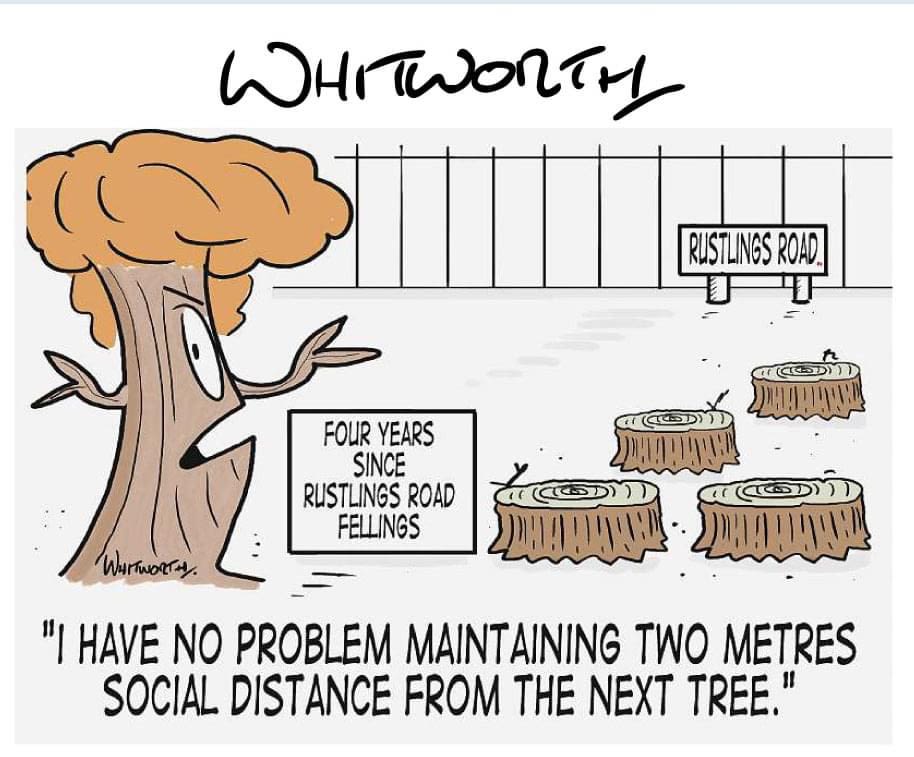
A cartoon from November 2020, highlighting the four year anniversary of the Rustlings Road fellings. Credit: James Whitworth
A cartoon from November 2020, highlighting the four year anniversary of the Rustlings Road fellings. Credit: James Whitworth

"Rot in hell Amey". Photo: Helen Shipley
"Rot in hell Amey". Photo: Helen Shipley
Chippinghouse Road

Alison Teal joined the campaign in 2015, and was elected to Sheffield City Council as a Green Party Councillor a year later, on a platform of promising to hold the council to account over the tree felling scandal.
She said: “Even Labour campaigners were campaigning to get me elected because they were so upset about the tree dispute and what had been going on. They didn’t want Labour to be rewarded for their bad behaviour.”
Councillor Teal became a key member of the campaign, especially from a political point of view, but being a councillor didn’t stop her from attending any of the protests. Instead, it simply made things all the more eye catching when she was arrested during one.
In the video below, Councillor Teal explains what it was like on the day that she was arrested, which all started when Paul Brooke, who later became chair of STAG, decided to breach the safety barriers on Chippinghouse Road and stop one of the trees from being felled.
The charges against all seven, including Councillor Teal, were eventually dropped, as the trade union legislation used to arrest them was deemed unlawful. However, the actions from that day raised tensions further, and by the middle of 2017 it was clear that things were getting out of hand.
Protesters were clashing with Amey more often, and South Yorkshire Police had stopped involving themselves in the protests, following a very public condemnation by the Police and Crime Commissioner, Alan Billings. All of the arrests that had been made earlier that year and at the tail end of 2016 were found to have been unlawful, which meant that the charges against the 14 protestors who had been arrested from November to March were dropped.
Alan Billings, South Yorkshire’s Police and Crime Commissioner, said: “I was publicly critical of the force, because when they started knocking on doors on Rustlings Road it really wasn’t right.
“They should have been there to ensure that law and order was kept, not to do what the contractors should be doing, which is knocking on doors and telling people things.
“They used a lot of trade union legislation, or anti-trade union legislation, to make the arrests and that was controversial too.
“You might be able to do something but the law is not the only thing a police force has to think about. Yes it has to enforce the law, but it also has to take public opinion with it or very quickly you’re not policing by consent which is basic to our policing in this country.
“So there were a lot of tricky issues, and the force didn’t always get that right.”
It wasn’t just South Yorkshire Police who wanted to back out of what was quickly becoming a nationally broadcast disaster. Amey, who were contractually obliged to keep felling trees, wanted out.
Paul Selby, one of the tree campaign's most influential members, said: “By August 2017 Amey were pleading with the council to stop the felling, the council ordered - because they were allowed to, because that was part of the contract - the council ordered Amey to continue down the route no matter how much it cost.
“There was nothing Amey could do, they pushed harder and harder with the council to stop, saying there’s literally nothing we can do, we’re spending £40,000 a day on private security and we’re managing if we’re lucky to fell one tree a day, this is gonna take us years to finish.”
The council doubled down once more. The trade union legislation being used to arrest protesters had been deemed unlawful, so Sheffield City Council went back to the drawing board, and returned with a new idea to stop the protests - an injunction.

Councillor Teal was arrested during the protests. Photo: Simon Crump
Councillor Teal was arrested during the protests. Photo: Simon Crump

Photo: Scott Merrylees
Photo: Scott Merrylees

Protest on Ecclesall Road in 2017. Photo: Fran Grace
Protest on Ecclesall Road in 2017. Photo: Fran Grace
The injunction
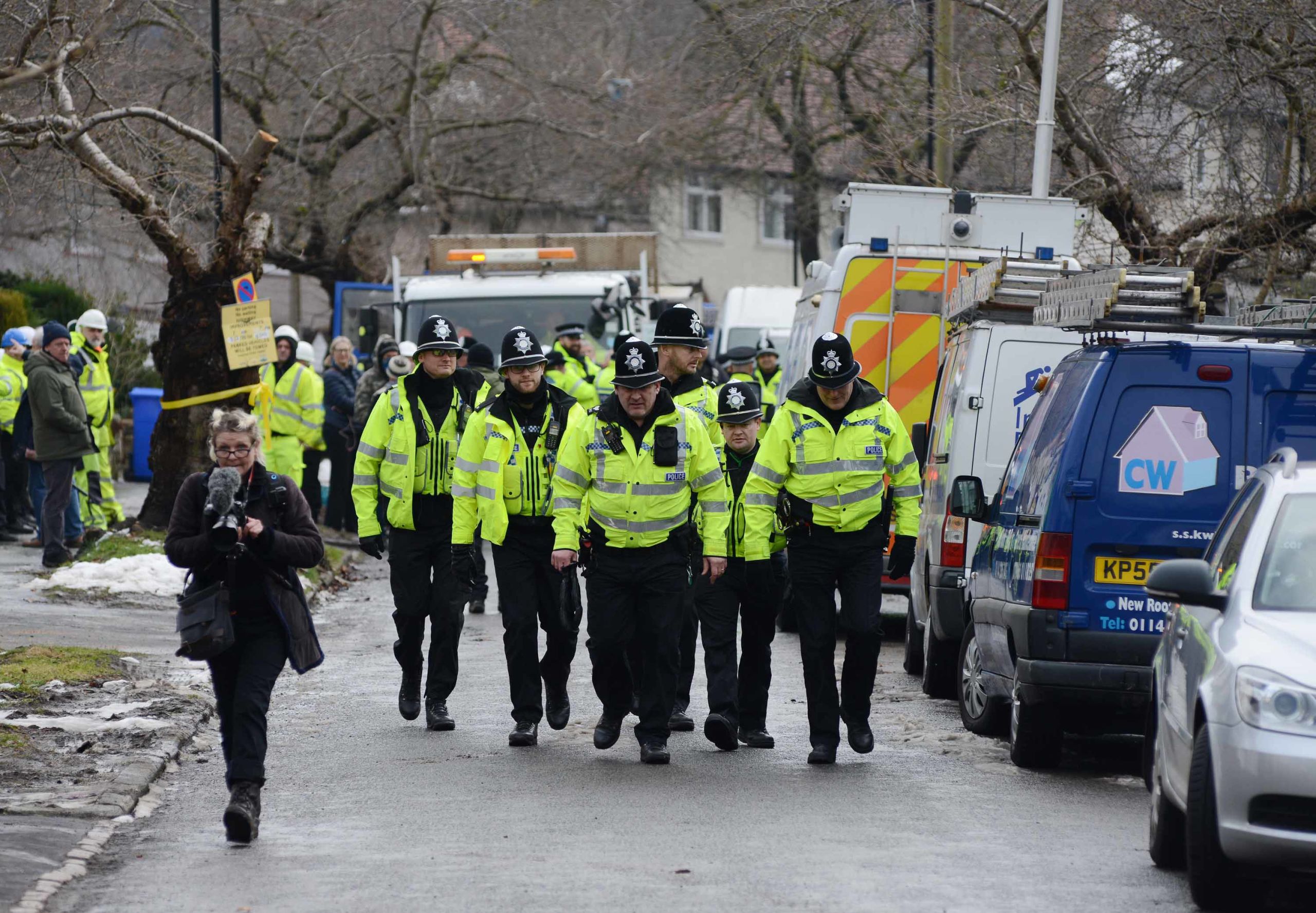
By August 2017 around 5,000 trees had been felled across Sheffield, and the council went for what they hoped would be a killing blow. They approached the High Court and were granted an injunction against several named protestors - Councillor Teal and Calvin Payne among them - as well as “persons unknown”.
Calvin admitted: “We had a feeling we were going to be injuncted against, those of us who had been arrested.
“But I didn’t see the 'persons unknown' bit coming, we didn’t really understand what that meant at first.”
The injunction meant that protesters who breached barriers and sat under trees (the main tactic used to prevent fellings) would be arrested. At first campaigners thought that this only applied to those who had been named in the injunction, but it quickly became clear that the “person's unknown” section gave Sheffield City Council huge scope - they could arrest anyone and everyone who crossed safety barriers.
Calvin said: “When the council got that injunction, I think they just expected us to put our hands up and walk away, but we couldn’t do that, we’d gone that far, we couldn’t just stop.”
It didn’t take long for the injunction to be tested - 37 days, in fact.
Calvin said: “It was the worst time of the campaign for me, it took me 37 days to breach it, I regret that it took me that long honestly.
“I should have done it on day one.”
Calvin Payne was the first protester to be arrested for breaching the injunction, but he was far from the last. He was handed a suspended prison sentence, and £16,000 in costs.
He believes that the verdict served as a catalyst for others to also breach the injunction: “The thing is, I broke the injunction in such an obvious way, with no repent and no apology, which meant that seeing that I didn’t get locked up, everyone realised that they weren’t going to be either.” Calvin said.
The controversy surrounding the injunction continued for months. Police got involved again, attempting to enforce the injunction which was so widely hated by the thousands of campaigners, which led to serious tensions between the police and protestors.
Calvin said: “When the police came back, they came back 30 or 40 strong every day and they occupied streets like there was a riot going on when there’s a few old people and a French poet out there.”
South Yorkshire Police were approached for an interview to discuss the concerns, but did not comment. In 2018, Assistant Chief Constable David Hartley said: "In terms of making sure that we're proportionate, fair and even-handed, things haven't changed, the policing style and the numbers has changed.
"We've seen the move from largely peaceful protest turn into some disorder, so we had to change our approach."
Things were getting gradually worse. More and more people were willing to breach the injunction and face arrest, perhaps spurred on by the leniency shown towards Calvin in his sentence.
Tensions continued to rise day in, day out for the rest of the year, and by the time 2018 rolled around it all seemed ready to erupt.

Protesters trying to protect a tree on Meersbrook Park Road. Photo: Luis Arroyo
Protesters trying to protect a tree on Meersbrook Park Road. Photo: Luis Arroyo

The number of police used to enforce the injunction drew criticism. Photo: Alison Teal
The number of police used to enforce the injunction drew criticism. Photo: Alison Teal
The Beast From The East

“By January 2018 it was clear that the end was coming, we were either going to win or we were going to lose, they were upping the stakes”
Calvin Payne
Protests had been raging for three years by the time the “Beast From The East” hit Sheffield, bringing freezing temperatures and heavy snow at the start of March. The freakish weather didn't see protests let up though - it just made events even more surreal.
Below, campaigner Paul Selby reflects on the unique day of protesting which took place on Thornsett Road during the "Beast From The East", and what it was like being there.
Photo: Calvin Payne

That week ended up being one of the final attempts at felling. Even with the injunction in place, it was proving impossible for Amey to work - they only managed to fell 200 trees in the final four months of 2017, and physical clashes with protesters were becoming worryingly frequent.
The violence finally reached its peak at the end of March, on Meersbrook Park Road.
The day started out the same as any other day, with Amey showing up to fell trees, a heavy police presence in tow, and protesters on the road hurling abuse at them. This time, though, something snapped.
Protesters from the day allege that what caused things to boil over was a private security guard being far too rough with an elderly protester.
Paul said: “The security guards were really rough with some elderly residents on the road who were blocking the felling. They were screaming out in pain, so some of the campaigners charged down the metal barriers to prevent what they believed was a crime.
“Battering down barriers, that then created a reaction from both the security guards and the police who thought there was a riot going on."
Calvin said: “You just had someone scream: ‘Everyone in!’, and that was it, the fences went down and everyone rushed in, 50 people just stormed this tree and broke the injunction, it was incredible.”
It was that day where the council finally found their limit. For the first time in three years, one of the sides blinked. Sheffield City Council backed down, and took a step back.
A temporary halt to felling was announced. It was far from over, but for the first time there seemed to be light at the end of the tunnel.
However, the pause was only temporary, and it was widely believed that the council would come back with a vengeance. It was going to take more than a riot to save the remaining 11,500 trees.

By the end of the fellings, there were crowds on every street. Photo: Scott Merrylees
By the end of the fellings, there were crowds on every street. Photo: Scott Merrylees

A masked protester ties themselves to a tree on Meersbrook Park Road. Photo: Luis Arroyo
A masked protester ties themselves to a tree on Meersbrook Park Road. Photo: Luis Arroyo

One of the final days of felling on Kenwood Road. Photo: Paul Selby
One of the final days of felling on Kenwood Road. Photo: Paul Selby
The end of the felling

In the end, it wasn’t the protests that stopped the fellings for good, but a criminal investigation.
Paul Selby was invaluable to the tree campaign for a number of reasons. He didn’t get too involved in the protests, but he knew the ins and outs of what Sheffield City Council could and couldn’t legally do.
Most importantly, he knew that there would need to be a compromise in order to save the trees.
Paul said: “Other campaigners were very much of the opinion that there should be no compromise, that it was black and white with no shades of grey.
“But in any argument, anywhere in history, there’s always a shade of grey, it might be 99 per cent to 1 per cent or it could be 50/50, but there’s always a shade of grey.
“No one’s 100 per cent right, ever.”
There was the occasional compromise that Paul was able to engineer during the protests for individual trees, but the council were unwilling to budge on their overall convictions.
That was forced to change when they were investigated by the Forestry Commission over whether their felling of trees was illegal.
The Forestry Commission is a national government department responsible for the country’s forests and trees, and is closely aligned with the Department for Environment.
As a result, Environment Secretary Michael Gove’s visit to Sheffield proved to be one of the most crucial points of the campaign. Following talks with protesters, he said that he would do whatever he could to help them: all they had to do was ask.
Paul latched on to the opportunity, and with the help of Gove, convinced the Forestry Commission to investigate the council over their felling of trees.
The commission began their investigation in April 2018 whilst the temporary halt to fellings was in place, and told the council that they could not resume felling until the investigation was over.
It meant that what would have likely been a pause to fellings for a few weeks became an 18 month ban whilst the investigation took place. It took the wind out of the council's sails, and killed any appetite that they had left for felling.
Paul said: “The council had a gun put to its head and was forced to the table by the Forestry Commission.
“They’d tried virtually everything, but they just couldn’t get out of it. They had to compromise with us.”
A new plan
It took almost half a year, but by September 2018, talks began between Sheffield City Council, Amey and STAG.
From there, things calmed down considerably. Since talks began, there has not been a single serious protest.
Things are still heated, grudges are still held, but nobody has been arrested over Sheffield’s street trees for over three years now. It’s a remarkable turnaround considering the aggression seen by both sides in the early months of 2018.
In December 2018, Sheffield City Council, Amey and STAG released a statement, promising to work together on Sheffield’s street trees and not let things get back to how they were during the protests.

Paul Selby (right) with other campaigners. Photo: Paul Selby
Paul Selby (right) with other campaigners. Photo: Paul Selby

Michael Gove (right) speaking to Councillor Teal. Photo: Simon Crump
Michael Gove (right) speaking to Councillor Teal. Photo: Simon Crump

"Trees Matter". Photo: Deerhund Shetty
"Trees Matter". Photo: Deerhund Shetty
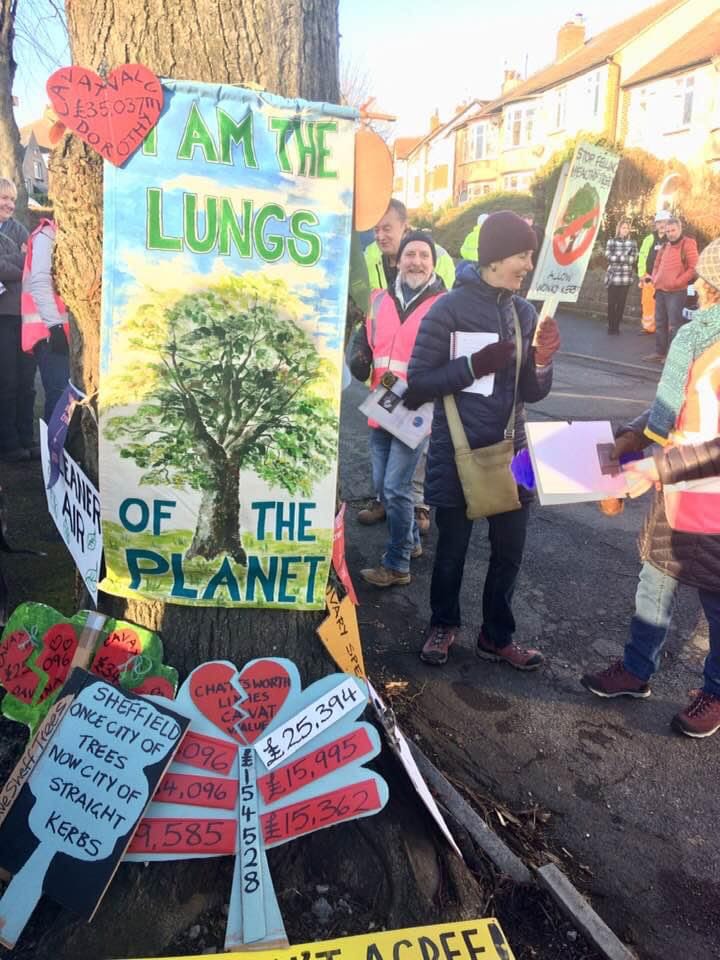
"I am the lungs of the planet". Photo: Fran Grace
"I am the lungs of the planet". Photo: Fran Grace
This meant that every tree which had been marked for felling was evaluated again, this time in partnership between Amey and STAG. As of July 2019, under this new joint inspection, less than one per cent of trees that had previously been marked for felling were chopped down.
It’s a jaw dropping statistic that brings out mixed emotions for campaigners. The solutions that are now used on a daily basis to save trees were pleaded for by STAG members for years.
Calvin said: “Everything’s very sensible now, it all works and has done for two years. But the repair work that they’re doing now is happening so easily and cheaply and it’s all so obvious that it annoys us even more.
“On Meersbrook Park Road we were battling them for months, there were 20 or 30 separate days including a couple of whole weeks where scores of people were arrested, or hurt or roughed up.
“Now, you’ve literally just got two blokes with a shovel and a drill who repair the kerb and they’re fine, it’s honestly extraordinary. So why did they spend half a million quid going to court, destroying people’s lives, and telling a judge that what we were asking for couldn’t be done? It doesn’t make any sense.”
It's anger and confusion like this which will still loom large for years to come. However, the council are hoping that the new street tree strategy being released on Monday will go some way to repairing these relationships.
Sheffield's tree protests: the key roads
Click on the icons below to find out more on each road
Sheffield’s Street Tree Strategy
After two and a half years of talks, the soon-to-be unveiled strategy is hoped to be another step in the right direction. The strategy will focus heavily on ensuring that all future street tree decisions are taken transparently, that the trees planted are more resilient, and that canopy cover is increased.
The promise for further transparency is clearly one that Sheffield City Council are keen to draw attention to - it’s the first outcome detailed in the strategy, and it’s the one that will be most important to the people whose lives drastically changed as a result of the council's actions in the past.
When it comes to the promises laid out in the strategy, campaigners couldn’t be happier. Calvin said: “This strategy is something that was called for right at the start of the campaign in 2015, and it’s exactly what we want it to be.
“We’re running the policy in Sheffield when it comes to street trees, which is incredible considering where we were three years ago.”
It’s a rare sight to see the Sheffield City Council and STAG members united in favour of something, but this strategy has managed to achieve that. In a recent council meeting, Mark Jones, Cabinet Member for Environment, thanked both council officers and STAG members for contributing to the "progressive and inclusive" strategy.
Councillor Jones continued: “Much still remains to be done, but this is an important step on a very long journey that will hopefully never end as we better understand how to manage our urban environment.”
Many people who were involved in the street tree protests have moved on, now safe in the knowledge that with this street tree strategy, and the partnership between the council and STAG, things are in a much better place. However, what took place during those years of protests has had far reaching consequences for Sheffield, for the country, and for the individuals who devoted years of their lives to the campaign.

Protestors defending the tree that Michael Gove was pictured with, which came to be known as "Gove's tree". Photo: Paul Selby
Protestors defending the tree that Michael Gove was pictured with, which came to be known as "Gove's tree". Photo: Paul Selby

Thousands of trees destined for felling have now been saved. Photo: Angela Howard
Thousands of trees destined for felling have now been saved. Photo: Angela Howard

Both STAG members and the council alike are happy with where things are now. Photo: Simon Crump
Both STAG members and the council alike are happy with where things are now. Photo: Simon Crump
The future

It’s Our City
One of the biggest changes that has come about as a result of the protests took place just last week. A referendum on how Sheffield City Council is run took place during the local elections. It’s believed by many that this referendum never would have come about if the tree campaign hadn’t come before it.
Calvin said: “In the end, the politics did win out. We had to learn how the council works, and now we’ve got It’s Our City, we’ve got people trying to change the way the council works, the only reason that any of that happened is the tree campaign.
“Nobody would give a monkeys about Sheffield City Council's committee system if it wasn’t for this issue, it’s all come out of the tree campaign.”
The referendum was successful, and as a result from next year the council will be permanently changed. More councillors will have a say in the running of the council, as decisions will be taken via committees which will have councillors from each party. Before now, the council was simply run by a ten person cabinet.
Anne Barr, co-chair of It’s Our City, said: “The tree campaign had a great deal to do with the formation of IOC (It’s Our City).
“Regardless of what people thought about trees, the way decisions were taken around that campaign and the lack of willingness to engage with protesters, led to people starting to question how decisions are actually made by the council.
“The tree campaign has played a big role in bringing about this referendum.”
It’s not just Sheffield that has seen change come about as a result of the tree protests either. Nationwide, legislation has passed through the House of Commons to prevent what happened in Sheffield from ever happening again.
Paul said: “The big thing is we’ve changed UK legislation in relation to street trees, we got Michael Gove to introduce specific legislation to force councils to consult properly when they intend to fell street trees, that was the big goal.
“We’ve lost 5,500 trees here in Sheffield but in reality we’ve changed UK street tree legislation forever, and that’s the bit that makes me the most proud.”
“Irreparable distrust”
For some people, wounds haven’t healed over what happened during those controversial years, and they may never.
Talking about what things are like at the council now, Councillor Teal said: “Some of the Labour councillors are alright with me, but some of them aren’t.
“There’s still resentment, working remotely has been a bit of a help really because it’s quite stressful for me to be in the full council chamber because of the way I’ve been treated.”
For Calvin, whose life was changed forever as a result of the protests, it still feels surreal: “You have to pinch yourself sometimes, because there were times when we were out at 4 o’clock in the morning having car chases, trying to find out what trees they’re going to try and cut down next.
“There’s irreparable distrust as a result now. I don’t know how people have sat in those strategy meetings with the council and Amey, I couldn’t have done it knowing the things they’ve done.
“If I had tried to do it there would have been desks going over, there’s no way I could sit opposite them, people who tried to have you locked up.”
From the council's point of view, it’s hoped that relationships can be further reconciled with an archive, which is due to be finished by July.
Mick Crofts, Executive Director for Place at Sheffield City Council, has worked extensively on the street trees controversy since becoming involved in 2019. As a fresh face who came in following the protests, he’s regarded positively by many protesters.
Speaking about the new street tree strategy, and the archive, he said: “The purpose of the archive is to recognise that it has been a significant issue in Sheffield’s history and should be recorded for the future.
“If I’m being honest I don't think the new strategy has drawn a line under the situation for some people in the city yet, but those are people that are backward looking for personal and understandable reasons.
“We’ve kept the focus on looking forward for the city, and moving forward. I think the street tree strategy is a significant step forward in that, and it certainly articulates shared ambitions and partnership going forward.”
Moving forward
For many of the protesters, it’s more important to look to the future than worry about what happened in the past now.
STAG has recently held elections, to try and figure out what its future direction is going to be. For Paul, looking to the future isn’t only important because the tree campaign is over and won, but also because the campaign itself wasn’t quite as perfect as it has been held up to be in victory.
Paul said: “The interesting thing about the campaign was that after brokering the very first compromise of the campaign, to save a tree, I very nearly quit the campaign right after, because of the bullying I received from other members of the campaign for compromising to save this tree.
“There were multiple times where I had to intervene at STAG, because there were absolutely brutal arguments between members.
“The weird thing was if only the council knew how divided the campaigners were they could’ve exploited that because it was honestly really, really bad. It was vicious between some campaigners and other campaigners. It was horrible.
“But what I’ve heard subsequently is that it’s the same in all campaigns; Extinction Rebellion, Momentum in Labour, every campaign is vicious and that’s why most campaigns fail because they don’t continue the united front.
“STAG, for all it’s flaws and for all the viciousness, we maintained a united front in public.”
Despite the tensions within STAG, and the aggression shown towards the council, things have ended up in a positive place. Both Sheffield City Council and STAG are happy with where things are now and where they’re heading.
Paul said: “In terms of the future, there’s no question.
“I’m convinced and confident that everything’s already in the right direction and beyond our wildest dreams.
“I would actually go as far to say that albeit, we’ve lost 5,500 trees, but now we have more than what we ever expected to achieve in terms of the future.”
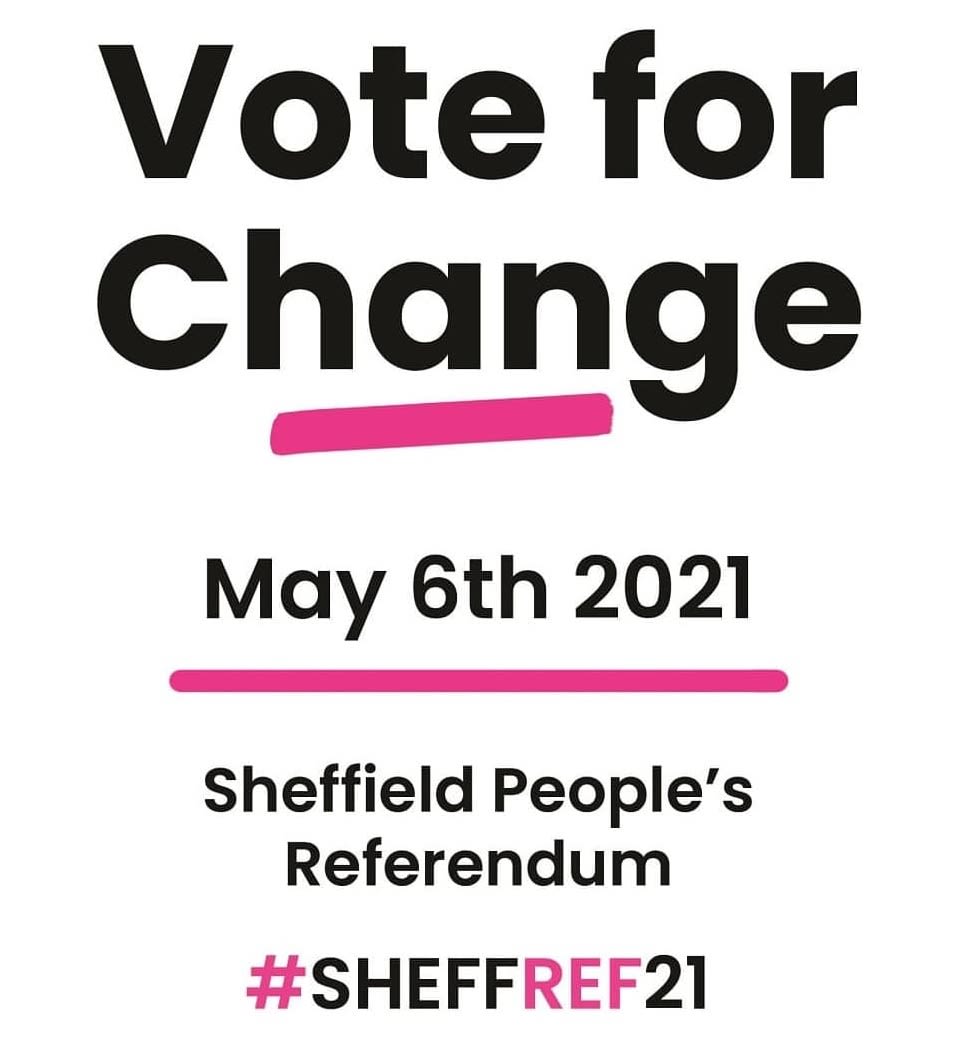
A referendum to change how the council is run has been successful. Credit: It's Our City
A referendum to change how the council is run has been successful. Credit: It's Our City

Even now, signs like this are still frequently seen in people's windows around Sheffield
Even now, signs like this are still frequently seen in people's windows around Sheffield

A STAG fundraiser to pay for protesters legal costs. Photo: Fran Grace
A STAG fundraiser to pay for protesters legal costs. Photo: Fran Grace

Protesters on Chelsea Road, where Paul struck the first compromise of the campaign. Photo: Paul Selby
Protesters on Chelsea Road, where Paul struck the first compromise of the campaign. Photo: Paul Selby
Today, Sheffield is one of the best cities in the country when it comes to tree planting, which will play a huge part in tackling the climate crisis in the years to come. However, if it weren't for the protests, it’s hard to imagine that the city would be in the position that it is now.
Calvin said: “99 per cent of protests and campaigns lose, it’s rare to win so comprehensively, especially when you consider the scale, everything was stacked against us and yet they were beaten by a group of people who didn’t have experience doing things like this, who often didn’t like each other, who didn’t agree with each other, we were unorganised, we made ludicrous mistakes at times, but we won.
“There were two fundamental reasons - we were right, we knew it and we never doubted it from day one, and also we weren’t going to stop.
“The reason why we took it as far as we did is because it had become about far more than just the trees.
“We’ve changed the way Sheffield’s street trees are treated, we’ve changed the way Sheffield is run, and we’ve also changed the way other towns and cities do this stuff, nobody else will ever do what is now known as ‘doing a Sheffield’ again.
“The legacy is huge, when I’m old and quite a few of our people are gone, there will be people referencing our campaign.
“We don’t need to celebrate what we’ve done, we go to bed every night knowing full well that we’ve achieved something.”
Photo: Alan Story

